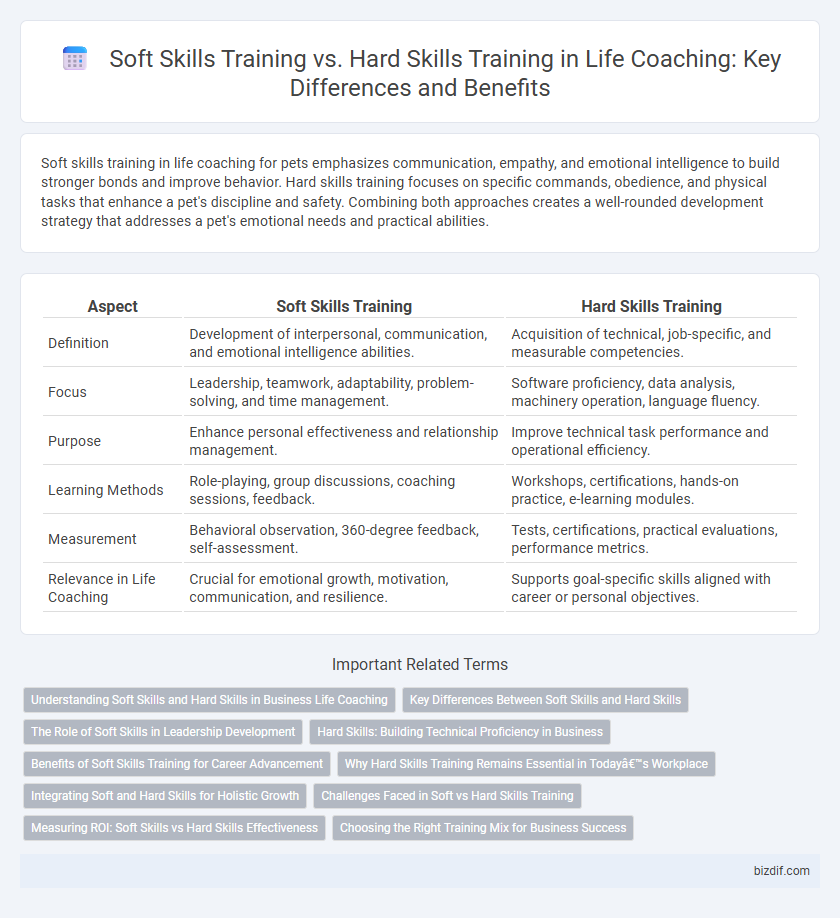Soft skills training in life coaching for pets emphasizes communication, empathy, and emotional intelligence to build stronger bonds and improve behavior. Hard skills training focuses on specific commands, obedience, and physical tasks that enhance a pet's discipline and safety. Combining both approaches creates a well-rounded development strategy that addresses a pet's emotional needs and practical abilities.
Table of Comparison
| Aspect | Soft Skills Training | Hard Skills Training |
|---|---|---|
| Definition | Development of interpersonal, communication, and emotional intelligence abilities. | Acquisition of technical, job-specific, and measurable competencies. |
| Focus | Leadership, teamwork, adaptability, problem-solving, and time management. | Software proficiency, data analysis, machinery operation, language fluency. |
| Purpose | Enhance personal effectiveness and relationship management. | Improve technical task performance and operational efficiency. |
| Learning Methods | Role-playing, group discussions, coaching sessions, feedback. | Workshops, certifications, hands-on practice, e-learning modules. |
| Measurement | Behavioral observation, 360-degree feedback, self-assessment. | Tests, certifications, practical evaluations, performance metrics. |
| Relevance in Life Coaching | Crucial for emotional growth, motivation, communication, and resilience. | Supports goal-specific skills aligned with career or personal objectives. |
Understanding Soft Skills and Hard Skills in Business Life Coaching
Soft skills training in business life coaching emphasizes interpersonal abilities such as communication, emotional intelligence, and teamwork that enhance leadership effectiveness and workplace relationships. Hard skills training focuses on technical expertise like data analysis, project management, and software proficiency, which directly impact job performance and operational tasks. Balancing soft and hard skills development drives career growth, improves problem-solving, and fosters adaptability in dynamic business environments.
Key Differences Between Soft Skills and Hard Skills
Soft skills training emphasizes interpersonal abilities such as communication, emotional intelligence, and teamwork, essential for effective collaboration and relationship-building in life coaching. Hard skills training focuses on technical competencies and knowledge specific to tasks, including data analysis, software proficiency, and industry-specific methodologies. Key differences between soft skills and hard skills lie in their application: soft skills enhance personal and social capabilities, while hard skills provide measurable, task-oriented expertise.
The Role of Soft Skills in Leadership Development
Soft skills training enhances emotional intelligence, communication, and adaptability, which are critical for effective leadership development. Unlike hard skills that focus on technical expertise, soft skills enable leaders to build trust, inspire teams, and navigate complex interpersonal dynamics. Investing in soft skills training leads to improved decision-making, conflict resolution, and overall team performance, making it indispensable for leadership success.
Hard Skills: Building Technical Proficiency in Business
Hard skills training in business emphasizes developing technical proficiency crucial for specialized roles, including data analysis, software mastery, and financial modeling. These skills provide measurable competencies that enhance productivity and career advancement opportunities. Investing in hard skills enables professionals to meet industry standards and drive operational efficiency effectively.
Benefits of Soft Skills Training for Career Advancement
Soft skills training enhances emotional intelligence, communication, and problem-solving abilities, which are critical for leadership and collaboration in the workplace. Developing skills like adaptability, empathy, and teamwork significantly boosts career advancement opportunities by fostering strong professional relationships and effective management capabilities. Employers increasingly prioritize these interpersonal competencies alongside technical expertise to drive organizational success and innovation.
Why Hard Skills Training Remains Essential in Today’s Workplace
Hard skills training remains essential in today's workplace because it provides employees with specific technical proficiencies and expertise critical for job performance and career advancement. Mastery of hard skills such as coding, data analysis, or project management ensures measurable productivity and contributes directly to organizational goals. While soft skills enhance communication and teamwork, hard skills form the foundation for executing professional tasks with accuracy and efficiency.
Integrating Soft and Hard Skills for Holistic Growth
Soft skills training enhances emotional intelligence, communication, and adaptability, which are critical for navigating interpersonal relationships and workplace dynamics. Hard skills training develops technical expertise and job-specific competencies necessary for task execution and career advancement. Integrating both soft and hard skills accelerates holistic growth by fostering well-rounded professionals capable of solving complex problems while effectively collaborating and leading teams.
Challenges Faced in Soft vs Hard Skills Training
Soft skills training often faces challenges such as subjectivity in assessment, difficulty in measuring behavioral changes, and resistance to change in mindset. Hard skills training encounters obstacles like rapidly evolving technology requiring constant updates and the need for hands-on practice to achieve proficiency. Bridging the gap between these trainings demands tailored approaches to address both emotional intelligence development and technical competency effectively.
Measuring ROI: Soft Skills vs Hard Skills Effectiveness
Measuring ROI in life coaching reveals that hard skills training typically demonstrates quicker, quantifiable results through improved task performance and productivity metrics, while soft skills training, such as communication and emotional intelligence, yields long-term benefits in team dynamics and leadership effectiveness. Organizations prioritizing ROI assessment should incorporate qualitative feedback, behavior change analytics, and employee engagement scores alongside traditional performance data to capture soft skills impact comprehensively. Balancing both training types enhances overall workforce capability, driving sustained organizational growth and improved interpersonal collaboration.
Choosing the Right Training Mix for Business Success
Soft skills training enhances communication, leadership, and emotional intelligence, fostering a collaborative workplace culture essential for business success. Hard skills training focuses on technical expertise and specific job functions, crucial for operational efficiency and innovation. Balancing both training types ensures employees are versatile, improving productivity and driving sustainable growth in competitive markets.
Soft skills training vs Hard skills training Infographic

 bizdif.com
bizdif.com